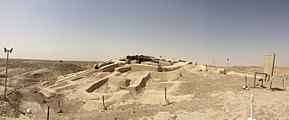Shahr-e Sookhteh
| شهرِ سوخته | |
 |
|
| Alternate name | Burnt City |
|---|---|
| Location | Sistan and Baluchestan Province, Iran |
| Region | Sistan |
| Coordinates | 30°35′43″N 61°19′35″E / 30.59528°N 61.32639°ECoordinates: 30°35′43″N 61°19′35″E / 30.59528°N 61.32639°E |
| Type | Settlement |
| History | |
| Abandoned | 2100 BCE |
| Periods | Bronze Age |
| Cultures | Jiroft culture |
| Site notes | |
| Condition | In ruins |
| Public access | yes ( 08:00 -19:00) |
| UNESCO World Heritage Site | |
| Criteria | Cultural: (ii), (iii), (iv) |
| Reference | 1456 |
| Inscription | 2014 (38th Session) |
|
[]
|
|
Shahr-e Sūkhté (Persian: شهرِ سوخته, meaning "[The] Burnt City"), also spelled as Shahr-e Sukhteh and Shahr-i Shōkhta, is an archaeological site of a sizable Bronze Age urban settlement, associated with the Jiroft culture. It is located in Sistan and Baluchistan Province, the southeastern part of Iran, on the bank of the Helmand River, near the Zahedan-Zabol road. It was placed on the UNESCO World Heritage List in June 2014.
The reasons for the unexpected rise and fall of the Burnt City are still wrapped in mystery. Artifacts recovered from the city demonstrate a peculiar incongruity with nearby civilizations of the time and it has been speculated that Shahr-e-Sukhteh might ultimately provide concrete evidence of a civilization east of prehistoric Persia that was independent of ancient Mesopotamia.
Covering an area of 151 hectares, Shahr-e Sukhteh was one of the world’s largest cities at the dawn of the urban era. In the western part of the site is a vast graveyard, measuring 25 ha. It contains between 25,000 and 40,000 ancient graves.
The settlement appeared around 3200 BCE. The city had four stages of civilization and was burnt down three times before being abandoned in 1800 BCE.
The site was discovered and investigated by Aurel Stein in the early 1900s.
Beginning in 1967, the site was excavated by the Istituto italiano per l'Africa e l'Oriente (IsIAO) team led by Maurizio Tosi. That work continued until 1978. After a gap, work at the site was resumed by the Iranian Cultural Heritage and Tourism Organization team led by SMS Sajjadi. New discoveries are reported from time to time.
Most of the material discovered is dated to the period of c. 2700-2300 BCE. The discoveries indicate that the city was a hub of trading routes that connected Mesopotamia and Iran with the Central Asian and Indian civilizations, and as far away as China.
Shahdad is another related big site that is being excavated. Some 900 Bronze Age sites have been documented in the Sistan Basin, the desert area between Afghanistan and Pakistan.
...
Wikipedia

